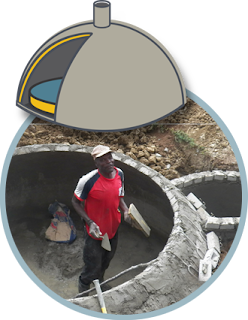A biodigester system utilizes organic waste, particularly animal and human excreta, to produce fertilizer and biogas. Graphic: GreenEnergy...
 |
| A biodigester system utilizes organic waste, particularly animal and human excreta, to produce fertilizer and biogas. Graphic: GreenEnergy. |
A Biodigester simply means a tank which digests organic material biologically. In this sense, the FilterPod is a biodigester. However, many people think of a biodigester as a tank that digests, anaerobically, without air, organic material and produces methane gas for cooking, lighting, and heating etc.
What is biogas?
Biogas is produced after organic materials (plant and animal products) are broken down by bacteria in an oxygen-free environment, a process called anaerobic digestion. Biogas systems use anaerobic digestion to recycle these organic materials, turning them into biogas, which contains both energy (gas), and valuable soil products (liquids and solids).
 |
| An advanced Biodigester / Bioreactor |
Biodigesters are the superb solutions for rural agrarian communities with intensive livestock farms, towns, and cities where the large volumes of domestic and animal wastes can produce significant quantities of methane. In rural areas, biodigesters are built in settlements where there is adequate animal manure.
 |
| Graphics: www.eesi.org |
New York City spends roughly $400 million each year to transport 14 million tons of waste to incinerators and landfills. Diverting that waste to anaerobic digestion would turn a cost into an opportunity, generating revenue from energy production and co-products.The potential for application of biogas technology on small-scale farms in the US is great for providing alternative means for managing on-farm organic wastes (manure, on-farm food processing) and providing a clean, renewable source of energy for on-farm applications (thermal energy for water heating, food processing, etc.). The United States currently has 2,200 operating biogas systems across all 50 states and has the potential to add over 13,500 new systems.
Making biogas technology a viable option for small farms requires the development of reliable, effective biogas reactors that can be readily fabricated and maintained by farmers. With support from the USDA Western Sustainable Agriculture Research & Education Program (Western SARE), CSANR developed a project to explore options for developing improved biogas technology for applications in small-farm settings in the US.
In Indian villages, larger units are made to serve a number of families or even a whole village. In China, where most rural families keep numerous pigs, the one family unit is common. To produce 1 m3 of BIOGAS, to cook 3 meals daily for a small family of 4 you need at least 5 litres of pig manure/day. 8 large pigs (breeding adults) will produce 5+ litres/day.
In Subsaharan and the whole continental Africa people are faced with serious issues of deforestation from excessive use of firewood for heat and cooking, health problems from poor air quality and pollution, harmful waste contaminating the environment, and a sheer lack of access to energy. Some upcoming renewable innovators have developed revolutionary biodigesters to address all of these pressing concerns.
The engineered the next generation Slurry-Separation Technology (SST) of biodigesters that tackles waste management at the source, generates alternative energy known as biofuel, and provides independence from water demands that tax households, agriculture, schools and businesses. Biodigesters' firms such as GreenLife and BlueFlame have installed over 580 biogas digesters in Kenya, Uganda, Mozambique, Togo, Ethiopia and Haiti, helping to create a reliable source of clean energy and organic fertilizer, all from unwanted waste products. Green Heat adds value to your waste! At the same time waste is being converted into energy, Green Heat is doing its part to reduce the reliance on non-sustainable biomass and mitigate deforestation.
- https://www.eesi.org/
- https://americanbiogascouncil.org/
- https://www.greenleafkenya.com/
- https://www.sciencedirect.com/science/article/pii/S1878029616301748
- https://www.blueflamebiodigesters.com/
- https://www.biodigester.com.ng/
- http://www.renewenergy.dk/
- https://greenzebragh.com/our-services/
- https://www.worldbiogasassociation.org/members/
- https://www.biotech-india.org/index.aspx
- https://www.maasenergy.com/






